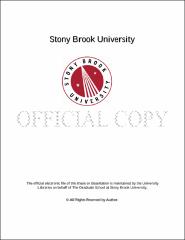| dc.identifier.uri | http://hdl.handle.net/11401/76658 | |
| dc.description.sponsorship | This work is sponsored by the Stony Brook University Graduate School in compliance with the requirements for completion of degree. | en_US |
| dc.format | Monograph | |
| dc.format.medium | Electronic Resource | en_US |
| dc.language.iso | en_US | |
| dc.publisher | The Graduate School, Stony Brook University: Stony Brook, NY. | |
| dc.type | Dissertation | |
| dcterms.abstract | Gallium Arsenide (GaAs) is the most widely used source of polarized electrons around the world. Electrons are extracted from a GaAs surface, terminated by a cesium-oxygen layer. The electrons are accelerated to form a beam by a DC electric field. This beam can ionize residual gas in the chamber, and the DC field accelerates the resulting ions into the cathode surface, damaging the Cesium- Oxygen layer. This process, called Ion Back Bombardment, is the dominant mechanism for limiting photocathode lifetime. As a result, high average current operation yields charge lifetimes too low to be used in a collider design. One idea to extend the charge lifetime is to funnel the beams from multiple cathodes using a rotating magnetic field--if operation of one cathode does not affect the operation of another cathode in the same chamber, then the source's lifetime can be extended by simply adding more cathodes. This dissertation presents the design, construction and commissioning of a unique electron gun capable of operating twenty cathodes. Results of funneling two electron beams with a rotating magnetic field are also presented. For average currents at 175 nA and 350 nA, the charge lifetimes for individual cathodes and two-cathode operation were measured, showing that the charge lifetime for two beam funneling is the sum of the individual ion back bombardment charge lifetimes. The addition of charge lifetime implies that beam funneling can be used to increase charge lifetime by an order of magnitude. | |
| dcterms.available | 2017-09-20T16:50:54Z | |
| dcterms.contributor | BEn-Zvi, Ilan | en_US |
| dcterms.contributor | Deshpande, Abhay | en_US |
| dcterms.contributor | Kharzeev, Dmitri | en_US |
| dcterms.contributor | Trbojevic, Dejan. | en_US |
| dcterms.creator | Rahman, Omer Habib | |
| dcterms.dateAccepted | 2017-09-20T16:50:54Z | |
| dcterms.dateSubmitted | 2017-09-20T16:50:54Z | |
| dcterms.description | Department of Physics | en_US |
| dcterms.extent | 97 pg. | en_US |
| dcterms.format | Application/PDF | en_US |
| dcterms.format | Monograph | |
| dcterms.identifier | http://hdl.handle.net/11401/76658 | |
| dcterms.issued | 2016-12-01 | |
| dcterms.language | en_US | |
| dcterms.provenance | Made available in DSpace on 2017-09-20T16:50:54Z (GMT). No. of bitstreams: 1
Rahman_grad.sunysb_0771E_12971.pdf: 17684454 bytes, checksum: 9fd225ddf3774b95cc750ab750a141ee (MD5)
Previous issue date: 1 | en |
| dcterms.publisher | The Graduate School, Stony Brook University: Stony Brook, NY. | |
| dcterms.subject | Physics | |
| dcterms.subject | Accelerator Physics, GaAs, Photocathodes, Polarized electron beam | |
| dcterms.title | Funneling electron beams from gallium arsenide photocathodes | |
| dcterms.type | Dissertation | |

